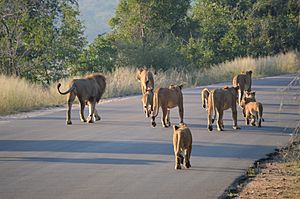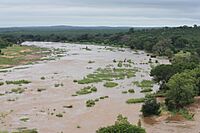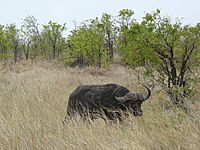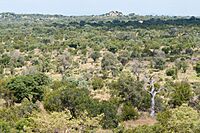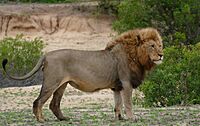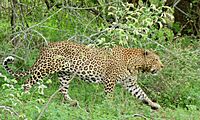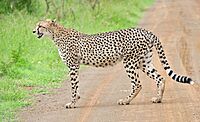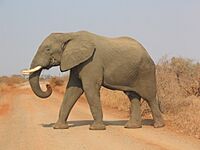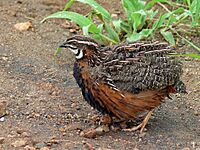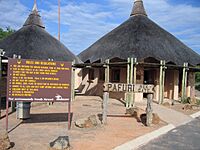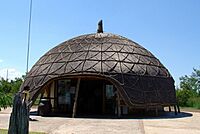Kruger National Park facts for kids
Quick facts for kids Kruger National Park |
|
|---|---|
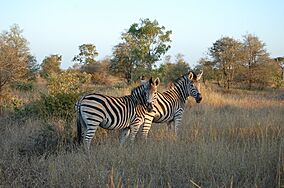
Plains zebras in a Kruger landscape
|
|

Location of the park (red area) in South Africa
|
|
| Location | Limpopo and Mpumalanga provinces, South Africa |
| Nearest city | Mbombela (southern) Phalaborwa (central) |
| Area | 19,623 km2 (7,576 sq mi) |
| Established | 31 May 1926 |
| Visitors | 1,659,793 (1,277,397 day visitors, 382,396 overnight) (in 2014–15 FY) |
| Governing body | South African National Parks |
The Kruger National Park is a famous national park in South Africa. It covers a huge area of about 19,623 square kilometers (7,576 square miles). This makes it one of the largest national parks in the world! You can find it in the Limpopo and Mpumalanga provinces, in the northeast part of the country.
The park stretches about 360 kilometers (224 miles) from north to south and 65 kilometers (40 miles) from east to west. Its main office is in a place called Skukuza. The first parts of the park were protected by the government way back in 1898. Then, in 1926, it officially became South Africa's very first national park. It's also part of the Kruger to Canyons Biosphere, which is a special area recognized for its unique nature.
Contents
History of Kruger National Park
The story of Kruger National Park began long ago, even before it was officially a park. People started thinking about protecting animals in the late 1800s.
Early Conservation Efforts
As early as 1867, some farmers realized that animals were disappearing. They put up notices to stop hunting on their own land. One of these farmers was Alexander Marsh Robertson. He even built a fence on his farm to keep his horses in. But he soon noticed that the fence also helped protect the wild animals living there. The number of animals in his fenced area grew a lot!
President Paul Kruger, a very important leader at the time, heard about Robertson's success. He visited the farm and was very impressed. This visit helped him realize how important it was to protect wildlife. He then shared his idea to create a large game reserve along the Sabi River. This was meant to protect big animals that needed a lot of space to live.
Sabi Game Reserve: The Beginning
In 1898, the Sabi Game Reserve was created. Its main goal was to stop too much hunting and protect the animals that were becoming fewer. This reserve covered the southern part of what is now Kruger National Park.
In 1902, James Stevenson-Hamilton became the first warden (or manager) of the reserve. Another area, the Singwitsi Reserve (named after the Shingwedzi River), was added in 1903. Over many years, local tribes living in these areas were moved to other lands. This happened so that the land could become part of the growing park.
By 1923, tourists started visiting the Sabi Game Reserve. They came on special train tours called "Round in Nine." These trains traveled along the Selati railway line, which went through the reserve.
Becoming Kruger National Park
In 1926, the Sabi Game Reserve, the Singwitsi Game Reserve, and other nearby farms were all joined together. This is when they officially became the Kruger National Park.
James Stevenson-Hamilton, the first warden, retired in 1946 after 44 years of dedicated work.
In 1959, work began to build fences around the entire park. The fences helped stop diseases from spreading, made it easier to patrol the borders, and prevented poachers from entering.
Later, in 1969, the Makuleke people were moved from their land in the northern part of the park. Their land was then added to Kruger National Park. However, in 1996, the Makuleke tribe asked for their land back. They won their land claim and got their land (about 198 square kilometers or 76 square miles) returned. Instead of moving back, they decided to work with tourism companies. Now, they earn money from lodges built on their land, which helps their community.
In the late 1990s, some fences between Kruger Park and nearby private game reserves were removed. This created a much larger area called the Greater Kruger Park, adding about 400 square kilometers (154 square miles) of land.
In 2002, Kruger National Park joined with Gonarezhou National Park in Zimbabwe and Limpopo National Park in Mozambique. Together, they formed a huge "peace park" called the Great Limpopo Transfrontier Park. This allows animals to move freely across the borders of these three countries.
Location and Geography
Kruger National Park is located in the northeast of South Africa. It's in the eastern parts of the Limpopo and Mpumalanga provinces. The town of Phalaborwa in Limpopo is the only South African town that borders the park.
The park is about 360 kilometers (224 miles) long. Its average width is 65 kilometers (40 miles), but at its widest point, it stretches 90 kilometers (56 miles) from east to west.
Two major rivers form the park's natural borders: the Limpopo River to the north and the Crocodile River to the south. To the east, the Lebombo Mountains separate the park from Mozambique. The western border runs about 65 kilometers (40 miles) away from these mountains.
The park's height above sea level changes quite a bit. It's about 200 meters (656 feet) high in the east and goes up to 840 meters (2,756 feet) in the southwest, near Berg-en-Dal. The highest point in the park is a hill called Khandzalive. Many rivers flow through the park from west to east, including the Sabie, Olifants, Letaba, and Luvuvhu rivers.
Climate of Kruger National Park
The climate in Kruger National Park is subtropical, which means it's usually warm. Summers are hot and humid, and this is also the rainy season, from September to May. The driest months are usually September and October, just before the rains begin.
Because the park is so long (360 kilometers from north to south), the weather can be a bit different in various parts. For example, the southern part of the park, around Skukuza, is usually a couple of degrees Celsius cooler than the northern part, around Pafuri. The south also gets more rain.
Amazing Biodiversity
Kruger National Park is famous for its incredible variety of plants and animals, also known as its biodiversity. It's like a giant outdoor classroom where you can learn about nature!
Plant Life
The park has four main types of plant areas, which roughly match the four corners of the park. These areas are shaped by how much rain they get (from 400 to 750 millimeters per year) and the type of rocks and soil.
- Shrub Mopane Veld: This covers most of the northeastern part of the park. It's dominated by small mopane trees.
- Red Bush-willow and Mopane Veld: Found in the western half, north of the Olifants River. Here, you'll see lots of red bush-willow and mopane trees.
- Thorn Trees and Red Bush-willow Veld: This area is in the western part, south of the Olifants River. It has many thorn trees and red bush-willows. You'll also find lots of marula trees here.
- Knob-thorn and Marula Veld: Located in the eastern half, south of the Olifants River. This area has important grazing lands for animals. Common trees include knob-thorn, leadwood, and marula.
Some smaller areas in the park have very special plants. For example, the Pretoriuskop and Malelane areas get more rain and have unique bushes. The sandveld in the northeast also has many special plant species.
Mammals of Kruger National Park
Kruger National Park is home to all of the famous "Big Five" animals: lions, leopards, elephants, rhinos, and buffalo. It has more types of large mammals (147 species!) than any other game reserve in Africa. You can even watch some of them on webcams set up in the park!
The park is also a safe place for African wild dogs, which are an endangered species. There are only about 400 of them left in all of South Africa, and Kruger helps protect them.
Here's a look at some of the animal numbers in the park:
| Species | Count (2009) | Count (2010) | Count (2011) |
|---|---|---|---|
| Black rhinoceros | 350 | 590–660 | – |
| Blue wildebeest | 9,612 | 11,500 | 6,400–13,100 |
| Plains zebra | 17,797 | 26,500 | 23,700–35,300 |
| African buffalo | 27,000 | 37,500 | 37,130 |
| African bush elephant | 11,672 | 13,700 | 13,750 |
| Giraffe | 5,114 | 9,000 | 6,800–10,300 |
| Greater kudu | 5,798 | 9,500 | 11,200–17,300 |
| Hippopotamus | 3,000 | 3,100 | 3,100 |
| Impala | 150,000 | 120,000 | 132,300–176,400 |
| White rhinoceros | 7,000 to 12,000 | 10,500 | – |
| African wild dog | 240 | – | 120 |
| Cheetah | 120 | 120 | 120 |
| Nile crocodile | – | 4,420 | 4,420 |
| Leopard | 2,000 | 1,000 | 1,000 |
| Lion | 2,800 | 1,600 | 1,620–1,720 |
| Spotted hyena | 2,000 | 3,500 | 5,340 |
Birds of Kruger National Park
Kruger National Park is a paradise for birdwatchers, with many different bird species. Most birds breed in the summer when there's plenty of food from the rains. However, larger birds of prey often breed in the dry winter when it's easier to find their prey.
Some birds are only found in tropical northern areas, but you can see them in Kruger. These include the African openbill, hooded vulture, and trumpeter hornbill. About 30 types of waterbirds and waders depend on the rivers and dams in the park. You might spot an African finfoot or a white-backed night heron.
There's a special group of birds called the "Big Six Birds" because they are large and need big areas to live. These are the lappet-faced vulture, martial eagle, saddle-billed stork, kori bustard, ground hornbill, and the shy Pel's fishing owl.
Other Animals
Kruger is home to 114 types of reptiles, including black mambas, African rock pythons, and about 3,000 Nile crocodiles. There are also 34 species of amphibians (like frogs and toads) and 49 types of fish. Amazingly, a bull shark was even caught in the Limpopo River in 1950! These sharks can swim far up rivers from the ocean.
Insects and Spiders
The park is buzzing with tiny creatures too! There are 219 species of butterfly and skipper. The total number of moth and butterfly species might be around 7,000. The mopane moth is well-known in the northern part of the park.
Kruger also has many types of termites, including those that build large mounds. Scientists even discovered a new type of woodlouse living inside termite nests in the park!
As of 2018, there are 350 known species of arachnids (spiders and their relatives) in Kruger. This includes 7 types of baboon spider, 9 types of scorpions, and many other fascinating creatures.
Challenges and Threats
The Kruger National Park faces several challenges that can affect its amazing ecosystem. These include:
- Poaching: This is a serious problem, where people illegally hunt animals, especially rhinos, for their horns.
- Development: New towns and buildings near the park's borders can impact the wildlife.
- Climate Change: Global warming and droughts can change the environment and make it harder for animals to find food and water.
- Animal Overpopulation: Sometimes, certain animal populations grow too large, which can put a strain on the park's resources.
- Mining Projects: There are concerns about mining activities near the park that could harm the environment.
- Light Pollution: Lights from rest camps and nearby towns can affect animals that are active at night, changing their behavior.
- Dams: Large dams on rivers that flow into the park can change the water flow and harm the river ecosystems.
Gates to the Kruger Park
To enter Kruger National Park, you need to go through one of its official gates. Here are the main gates:
| Name | Road | From Town | Coordinates |
|---|---|---|---|
| Crocodile Bridge Gate | on the extension of Rissik Street | from Komatipoort | 25°21′30″S 31°53′37″E / 25.35833°S 31.89361°E |
| Malelane Gate | on the R570 off the N4 | near Malelane | 25°27′43″S 31°31′59″E / 25.46194°S 31.53306°E |
| Numbi Gate | on the R569 road | from Hazyview | 25°9′19″S 31°11′51″E / 25.15528°S 31.19750°E |
| Phabeni Gate | on the road off the R536 | from Hazyview | 25°01′30″S 31°14′29″E / 25.02500°S 31.24139°E |
| Paul Kruger Gate | on the R536 road | from Hazyview | 24°58′53″S 31°29′7″E / 24.98139°S 31.48528°E |
| Orpen Gate | on the R531 road | from Klaserie | 24°28′33″S 31°23′27″E / 24.47583°S 31.39083°E |
| Phalaborwa Gate | on the R71 road | from Phalaborwa | 23°56′44″S 31°9′54″E / 23.94556°S 31.16500°E |
| Punda Maria Gate | on the R524 road | from Thohoyandou | 22°44′18″S 31°0′33″E / 22.73833°S 31.00917°E |
| Pafuri Gate | on the R525 road | from Musina | 22°24′1″S 31°2′29″E / 22.40028°S 31.04139°E |
See also
- Battle at Kruger
- Great Limpopo Transfrontier Park
- Kruger to Canyons Biosphere
- List of protected areas of South Africa
- Makuleke
- Sabi Sand Game Reserve
- Skukuza
Images for kids



